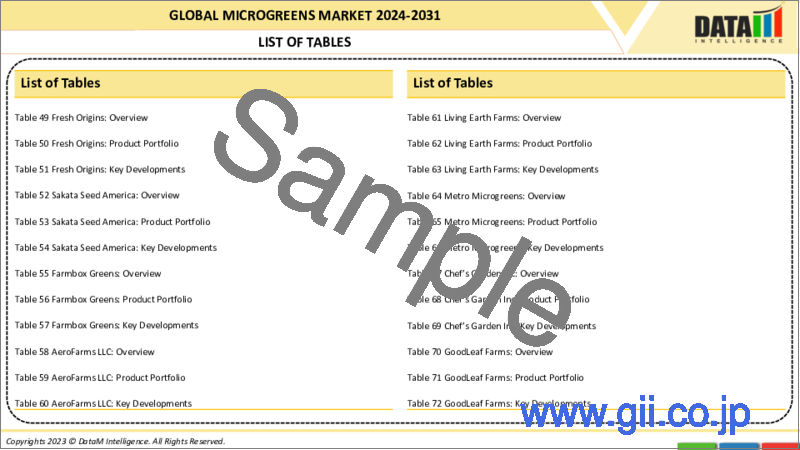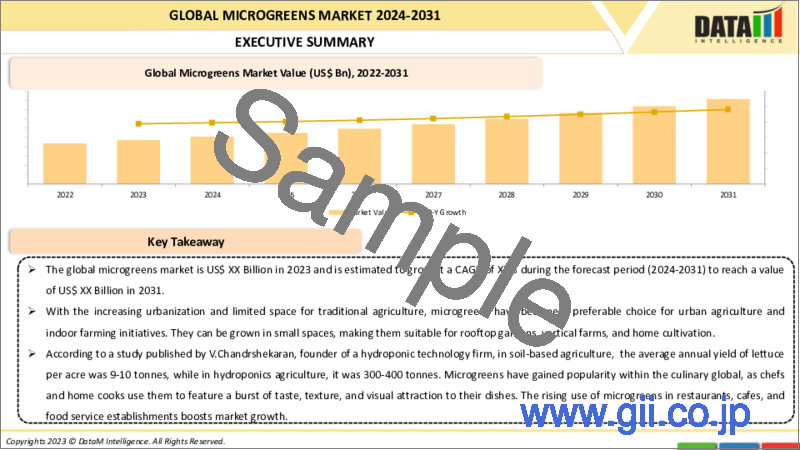|
|
市場調査レポート
商品コード
1336751
マイクログリーンの世界市場-2023年~2030年Global Microgreens Market - 2023-2030 |
||||||
カスタマイズ可能
適宜更新あり
|
|||||||
| マイクログリーンの世界市場-2023年~2030年 |
|
出版日: 2023年08月22日
発行: DataM Intelligence
ページ情報: 英文 181 Pages
納期: 即日から翌営業日
|
- 全表示
- 概要
- 目次
概要
世界のマイクログリーン市場は2022年に17億米ドルに達し、2023年から2030年の予測期間中にCAGR 13.1%で成長し、2030年には45億米ドルに達すると予測されています。
健康とウェルネスへの注目が高まるにつれて、栄養密度の高い食品に対する消費者の需要が高まっています。濃縮された栄養素と健康上の利点を持つマイクログリーンは、フィットネス志向の消費者の間でスーパーフードの嗜好品として人気を博しています。堆肥で育てたブロッコリーのマイクログリーンは、成熟したものと比べて、リン、カリウム、マグネシウム、マンガン、亜鉛、鉄、カルシウム、ナトリウム、銅などのミネラルが1.15倍と2.32倍多いです。
マイクログリーンの鮮やかな色、ユニークな風味、繊細な外観は、料理の視覚的な魅力と味を高めるのに理想的です。料理業界は、視覚的に魅力的で革新的な料理のプレゼンテーションを作成するために、マイクログリーンを受け入れています。
市場力学
水耕栽培やエアロポニックスなど高度成長培地の採用増加
水耕栽培やエアロポニックスは、外部の気象条件に関係なく、マイクログリーンの通年栽培を可能にします。この継続的な生産により、新鮮なマイクログリーンの安定供給が保証され、消費者や外食産業からの一貫した需要に応えることができます。
水耕栽培とエアロポニックスは、従来の土耕栽培に比べ、成長速度が速く、収穫量も多いです。この生産性の向上は、限られたスペースで生産量を最大化することで生産者に利益をもたらします。水耕栽培技術企業の創業者であるV.Chandrshekaran氏が発表した研究によると、土壌を利用した農業では、1エーカー当たりのレタスの年間平均収穫量は9~10トンであったのに対し、水耕栽培では300~400トンでした。
高級食品への支出の増加
マイクログリーンは、胡椒風味からナッツ風味、刺激的な辛味まで、過度な風味と幅広い味のプロファイルを提供します。料理人や料理愛好家は、料理の味と見た目を向上させるためにマイクログリーンを使用することで、料理の多様性を認識しています。シェフの51%近くが、マイクログリーンは飲食店で猛烈なトレンドになると予測しています。マイクログリーンの高級な味と料理の魅力は、特別な食体験を求める消費者を惹きつけています。
マイクログリーンには様々な種類の植物があり、中には従来のサラダや料理にはあまり見られないエキゾチックなものもあります。目新しさやユニークな食体験を求める消費者は、多様な種類のマイクログリーンに惹かれ、高級品種の需要を牽引しています。米国コロラド州立大学食品科学・人間栄養学科が発表した報告書によると、回答者の平均半数(50.5%)が週に1~2回マイクログリーンを消費し、消費前の保存期間は6日以内(80.3%)でした。
短い賞味期限
マイクログリーンの賞味期限は短く、適切な保存条件下では数日しかもちません。例えば、4℃で14~21日間保存できるものもありますが、6℃に上げると保存期間は50%短くなります。この賞味期限の短さは、鮮度を確保するために効率的でタイムリーなサプライチェーン管理が必要となるため、流通にとって困難な状況をもたらします。
消費者は、腐敗する前にマイクログリーンを使用できなければ、マイクログリーンの購入をためらうかもしれません。このように鮮度保持期間が短い製品に無駄なコストをかけるリスクを感じると、潜在的な購買意欲をそがれる人も出る可能性があります。
COVID-19影響分析
パンデミックの間、人々は健康志向を強め、栄養価が高く免疫力を高める食品の需要が高まっています。マイクログリーンは栄養価が高いため、より健康的な選択肢を食生活に取り入れようとする消費者に好まれました。
しかし、マイクログリーン市場は、パンデミックの間、輸送制限と労働力不足によるサプライチェーンの混乱に直面しました。例えば、2020年のブロッコリーの総生産量は1,580万cwtで、2019年から5%減少しました。収穫面積も100,300エーカーで、2019年から4%減少しました。
目次
第1章 調査手法と調査範囲
第2章 定義と概要
第3章 エグゼクティブサマリー
第4章 市場力学
- 影響要因
- 促進要因
- 水耕栽培やエアロポニックスなどの高度成長培地の採用増加
- 高級食品への支出の増加
- 抑制要因
- 短い賞味期限
- 機会
- 影響分析
- 促進要因
第5章 産業分析
- ポーターのファイブフォース分析
- サプライチェーン分析
- 価格分析
- 規制分析
第6章 COVID-19分析
第7章 タイプ別
- アブラナ科
- キャベツ
- ブロッコリー
- カリフラワー
- その他
- キク科
- レタス
- チコリ
- その他
- アマランサス科
- アマランサス
- ホウレンソウ
- キヌア
- その他
- ウリ科
- マイクロキュウリ
- マイクロメロン
- その他
- シソ科
- バジル
- ミント
- ローズマリー
- その他
- レンズ豆
- タマネギ、ニンニク、ネギ
- その他
第8章 農場別
- 室内農業
- 温室栽培
- 垂直農法
- その他
第9章 培地別
- ココナッツ・コアー
- ピートモス
- 土壌
- ティッシュペーパー
- その他
第10章 流通チャネル別
- スーパーマーケット/ハイパーマーケット
- 小売店
- eコマース
- その他
第11章 エンドユーザー別
- 小売業
- フードサービス
- その他
第12章 地域別
- 北米
- 米国
- カナダ
- メキシコ
- 欧州
- ドイツ
- 英国
- フランス
- イタリア
- ロシア
- その他欧州
- 南米
- ブラジル
- アルゼンチン
- その他南米
- アジア太平洋
- 中国
- インド
- 日本
- オーストラリア
- その他アジア太平洋
- 中東・アフリカ
第13章 競合情勢
- 競合シナリオ
- 市況/シェア分析
- M&A分析
第14章 企業プロファイル
- Fresh Origins
- 会社概要
- 製品ポートフォリオと説明
- 財務概要
- SAKATA
- Farmbox Greens
- AeroFarms LLC
- Living Earth Farms
- Metro Microgreens
- Chef's Garden Inc
- Gotham Greens
- 2BFresh
- GoodLeaf Farms
第15章 付録
Overview
Global Microgreens Market reached US$ 1.7 billion in 2022 and is expected to reach US$ 4.5 billion by 2030, growing with a CAGR of 13.1% during the forecast period 2023-2030.
The increasing focus on health and wellness is increasing consumer demand for nutrient-dense foods. Microgreens, having concentrated nutrients and health benefits, have gained popularity as a superfood preference among fitness-conscious consumers. Compost-grown broccoli microgreens have 1.15 and 2.32 times more minerals, like phosphorus, potassium, magnesium, manganese, zinc, iron, calcium, sodium and copper, compared to their mature counterpart.
Microgreens' vibrant colors, unique flavors and delicate appearance make them ideal for enhancing the visual appeal and taste of dishes. The culinary industry has embraced microgreens to create visually stunning and innovative food presentations.
Market Dynamics
Increasing Adoption of Advanced Growth Mediums Such as Hydroponics and Aeroponics
Hydroponics and aeroponics enable year-round cultivation of microgreens, regardless of external weather conditions. This continuous production ensures a steady supply of fresh microgreens, meeting the consistent demand from consumers and food service establishments.
Hydroponics and aeroponics promote faster growth rates and higher crop yields compared to conventional soil-based methods. This increased productivity benefits growers by maximizing their output within a limited space. According to a study published by V.Chandrshekaran, founder of a hydroponic technology firm, in soil-based agriculture, the average annual yield of lettuce per acre was 9-10 tonnes, while in hydroponics agriculture, it was 300-400 tonnes.
Rise in Spending on Premium Food Products
Microgreens offer excessive flavors and a wide range of taste profiles, from peppery to nutty to tangy. Cooks and food lovers recognize the culinary versatility of microgreens, using them to elevate the taste and appearance of dishes. Nearly 51% of the chefs predict that microgreens are a raging trend in eateries. The premium taste and culinary appeal of microgreens attract consumers seeking exceptional dining experiences.
Microgreens come in a wide range of plant types, some of which are exotic and not commonly found in traditional salads or dishes. Consumers seeking novelty and unique food experiences are drawn to the diverse selection of microgreens available, driving demand for premium varieties. According to a report published by the Department of Food Science and Human Nutrition, Colorado State University, USA, on average one-half of respondents (50.5%) consumed microgreens 1-2 times per week and stored them 6 days or less (80.3%) before consumption.
Short Shelf Life
Microgreens have a short shelf life lasting only a few days under proper storage conditions. For instance, At 4°C (39°F), the shelf life for some microgreens are 14-21 days but when the temperature is increased to 6°C (11°F) and the shelf life is reduced by 50%. This short shelf life poses a challenging situation for distribution as it requires efficient and timely supply chain management to ensure freshness.
Consumers may be hesitant to purchase microgreens if they won't be able to use microgreens before they spoil. The perceived risk of wasting money on a product with such a short freshness window might discourage some potential buyers.
COVID-19 Impact Analysis
During the pandemic, people became more health-conscious which drives demand for nutritious and immune-boosting foods. Microgreens, considered for their high nutritional content, were preferable by consumers looking to incorporate more healthful options into their diets.
However, the microgreens market faced supply chain disruptions due to transportation restrictions and labor shortages during the pandemic. For instance, the total production of broccoli in 2020 totaled 15.8 million cwt, down 5% from 2019. The area harvested, at 100,300 acres, was also down 4% from 2019.
Segment Analysis
The global microgreens market is segmented based on type, farm, growth medium, end-user, distribution channel and region.
Rising Demand For Brassicaceae for Different Culinary Application
The Brassicaceae family includes various microgreens varieties, like broccoli, radish, arugula, mustard and lettuce. Every variety provides distinct flavors, colors and textures, imparting a diverse selection for consumers and chefs. According to FAO, the total amount of lettuce produced in China was 14.36 million tons in 2021.
Brassicaceae microgreens are versatile in various culinary applications. They can be used as a garnish, added to salads, sandwiches and wraps or incorporated into a wide range of dishes to enhance their flavor and visual appeal. Consumers are increasingly seeking unique and premium food experiences and Brassicaceae microgreens offer just that. Their distinct flavors and attractive appearance appeal to adventurous eaters and food enthusiasts, driving demand for these microgreens.
Geographical Analysis
Asia-Pacific's Growing Urbanization
The growing urbanization in the region has led to increased demand for fresh, healthy and locally produced foods, including microgreens. In February 2023, An entrepreneur from Uzbekistan established the production of microgreens in the basement of a multi-story block. He supplies the products to local cafes, restaurants and supermarkets.
The popularity of urban agriculture and rooftop farming has been on the rise in the Asia Pacific region. Microgreens' quick growth cycle and suitability for indoor cultivation make them ideal choices for urban farming initiatives. In India, Chennai Entrepreneur earns INR 80K per month from microgreens with only a 10*10 room.
Competitive Landscape
The major global players include: Fresh Origins, SAKATA, Farmbox Greens, AeroFarms LLC, Living Earth Farms, Metro Microgreens, Chef's Garden Inc, Gotham Greens, 2BFresh and GoodLeaf Farms.
Why Purchase the Report?
- To visualize the global microgreens market segmentation based on type, farm, growth medium, end-user, distribution channel and region, as well as understand key commercial assets and players.
- Identify commercial opportunities by analyzing trends and co-development.
- Excel data sheet with numerous data points of microgreens market-level with all segments.
- PDF report consists of a comprehensive analysis after exhaustive qualitative interviews and an in-depth study.
- Product mapping available as Excel consisting of key products of all the major players.
The global microgreens market report would provide approximately 77 tables, 86 figures and 181 Pages.
Target Audience 2023
- Manufacturers/ Buyers
- Industry Investors/Investment Bankers
- Research Professionals
- Emerging Companies
Table of Contents
1. Methodology and Scope
- 1.1. Research Methodology
- 1.2. Research Objective and Scope of the Report
2. Definition and Overview
3. Executive Summary
- 3.1. Snippet by Type
- 3.2. Snippet by Farm
- 3.3. Snippet by Growth Medium
- 3.4. Snippet by Distribution Channel
- 3.5. Snippet by End-User
- 3.6. Snippet by Region
4. Dynamics
- 4.1. Impacting Factors
- 4.1.1. Drivers
- 4.1.1.1. Increasing Adoption of Advanced Growth Mediums Such as Hydroponics and Aeroponics
- 4.1.1.2. Rise in Spending on Premium Food Products
- 4.1.2. Restraints
- 4.1.2.1. Short Shelf Life
- 4.1.3. Opportunity
- 4.1.4. Impact Analysis
- 4.1.1. Drivers
5. Industry Analysis
- 5.1. Porter's Five Force Analysis
- 5.2. Supply Chain Analysis
- 5.3. Pricing Analysis
- 5.4. Regulatory Analysis
6. COVID-19 Analysis
- 6.1. Analysis of COVID-19
- 6.1.1. Scenario Before COVID
- 6.1.2. Scenario During COVID
- 6.1.3. Scenario Post COVID
- 6.2. Pricing Dynamics Amid COVID-19
- 6.3. Demand-Supply Spectrum
- 6.4. Government Initiatives Related to the Market During Pandemic
- 6.5. Manufacturers Strategic Initiatives
- 6.6. Conclusion
7. By Type
- 7.1. Introduction
- 7.1.1. Market Size Analysis and Y-o-Y Growth Analysis (%), By Type
- 7.1.2. Market Attractiveness Index, By Type
- 7.2. Brassicaceae*
- 7.2.1. Introduction
- 7.2.2. Market Size Analysis and Y-o-Y Growth Analysis (%)
- 7.2.3. Cabbage
- 7.2.4. Broccoli
- 7.2.5. Cauliflower
- 7.2.6. Others
- 7.3. Asteraceae
- 7.3.1. Lettuce
- 7.3.2. Chicory
- 7.3.3. Others
- 7.4. Amaranthaceae
- 7.4.1. Amaranth
- 7.4.2. Spinach
- 7.4.3. Quinoa
- 7.4.4. Others
- 7.5. Cucurbitaceae
- 7.5.1. Micro Cucumber
- 7.5.2. Micro Melons
- 7.5.3. Others
- 7.6. Lamiaceae
- 7.6.1. Basil
- 7.6.2. Mint
- 7.6.3. Rosemary
- 7.6.4. Others
- 7.7. Lentils
- 7.8. Onion, Garlic and Leeks
- 7.9. Others
8. By Farm
- 8.1. Introduction
- 8.1.1. Market Size Analysis and Y-o-Y Growth Analysis (%), By Farm
- 8.1.2. Market Attractiveness Index, By Farm
- 8.2. Indoor Farming*
- 8.2.1. Introduction
- 8.2.2. Market Size Analysis and Y-o-Y Growth Analysis (%)
- 8.3. Greenhouse Farming
- 8.4. Vertical Farming
- 8.5. Others
9. By Growth Medium
- 9.1. Introduction
- 9.1.1. Market Size Analysis and Y-o-Y Growth Analysis (%), By Growth Medium
- 9.1.2. Market Attractiveness Index, By Growth Medium
- 9.2. Coconut Coir*
- 9.2.1. Introduction
- 9.2.2. Market Size Analysis and Y-o-Y Growth Analysis (%)
- 9.3. Peat Moss
- 9.4. Soil
- 9.5. Tissue Paper
- 9.6. Others
10. By Distribution Channel
- 10.1. Introduction
- 10.1.1. Market Size Analysis and Y-o-Y Growth Analysis (%), By Distribution Channel
- 10.1.2. Market Attractiveness Index, By Distribution Channel
- 10.2. Supermarket/Hypermarket*
- 10.2.1. Introduction
- 10.2.2. Market Size Analysis and Y-o-Y Growth Analysis (%)
- 10.3. Retail Stores
- 10.4. E-Commerce
- 10.5. Others
11. By End-User
- 11.1. Introduction
- 11.1.1. Market Size Analysis and Y-o-Y Growth Analysis (%), By End-User
- 11.1.2. Market Attractiveness Index, By End-User
- 11.2. Retail*
- 11.2.1. Introduction
- 11.2.2. Market Size Analysis and Y-o-Y Growth Analysis (%)
- 11.3. Food Service
- 11.4. Others
12. By Region
- 12.1. Introduction
- 12.1.1. Market Size Analysis and Y-o-Y Growth Analysis (%), By Region
- 12.1.2. Market Attractiveness Index, By Region
- 12.2. North America
- 12.2.1. Introduction
- 12.2.2. Key Region-Specific Dynamics
- 12.2.3. Market Size Analysis and Y-o-Y Growth Analysis (%), By Type
- 12.2.4. Market Size Analysis and Y-o-Y Growth Analysis (%), By Farm
- 12.2.5. Market Size Analysis and Y-o-Y Growth Analysis (%), By Growth Medium
- 12.2.6. Market Size Analysis and Y-o-Y Growth Analysis (%), By End-User
- 12.2.7. Market Size Analysis and Y-o-Y Growth Analysis (%), By Distribution Channel
- 12.2.8. Market Size Analysis and Y-o-Y Growth Analysis (%), By Country
- 12.2.8.1. U.S.
- 12.2.8.2. Canada
- 12.2.8.3. Mexico
- 12.3. Europe
- 12.3.1. Introduction
- 12.3.2. Key Region-Specific Dynamics
- 12.3.3. Market Size Analysis and Y-o-Y Growth Analysis (%), By Type
- 12.3.4. Market Size Analysis and Y-o-Y Growth Analysis (%), By Farm
- 12.3.5. Market Size Analysis and Y-o-Y Growth Analysis (%), By Growth Medium
- 12.3.6. Market Size Analysis and Y-o-Y Growth Analysis (%), By End-User
- 12.3.7. Market Size Analysis and Y-o-Y Growth Analysis (%), By Distribution Channel
- 12.3.8. Market Size Analysis and Y-o-Y Growth Analysis (%), By Country
- 12.3.8.1. Germany
- 12.3.8.2. UK
- 12.3.8.3. France
- 12.3.8.4. Italy
- 12.3.8.5. Russia
- 12.3.8.6. Rest of Europe
- 12.4. South America
- 12.4.1. Introduction
- 12.4.2. Key Region-Specific Dynamics
- 12.4.3. Market Size Analysis and Y-o-Y Growth Analysis (%), By Type
- 12.4.4. Market Size Analysis and Y-o-Y Growth Analysis (%), By Farm
- 12.4.5. Market Size Analysis and Y-o-Y Growth Analysis (%), By Growth Medium
- 12.4.6. Market Size Analysis and Y-o-Y Growth Analysis (%), By End-User
- 12.4.7. Market Size Analysis and Y-o-Y Growth Analysis (%), By Distribution Channel
- 12.4.8. Market Size Analysis and Y-o-Y Growth Analysis (%), By Country
- 12.4.8.1. Brazil
- 12.4.8.2. Argentina
- 12.4.8.3. Rest of South America
- 12.5. Asia-Pacific
- 12.5.1. Introduction
- 12.5.2. Key Region-Specific Dynamics
- 12.5.3. Market Size Analysis and Y-o-Y Growth Analysis (%), By Type
- 12.5.4. Market Size Analysis and Y-o-Y Growth Analysis (%), By Farm
- 12.5.5. Market Size Analysis and Y-o-Y Growth Analysis (%), By Growth Medium
- 12.5.6. Market Size Analysis and Y-o-Y Growth Analysis (%), By End-User
- 12.5.7. Market Size Analysis and Y-o-Y Growth Analysis (%), By Distribution Channel
- 12.5.8. Market Size Analysis and Y-o-Y Growth Analysis (%), By Country
- 12.5.8.1. China
- 12.5.8.2. India
- 12.5.8.3. Japan
- 12.5.8.4. Australia
- 12.5.8.5. Rest of Asia-Pacific
- 12.6. Middle East and Africa
- 12.6.1. Introduction
- 12.6.2. Key Region-Specific Dynamics
- 12.6.3. Market Size Analysis and Y-o-Y Growth Analysis (%), By Type
- 12.6.4. Market Size Analysis and Y-o-Y Growth Analysis (%), By Farm
- 12.6.5. Market Size Analysis and Y-o-Y Growth Analysis (%), By Growth Medium
- 12.6.6. Market Size Analysis and Y-o-Y Growth Analysis (%), By End-User
- 12.6.7. Market Size Analysis and Y-o-Y Growth Analysis (%), By Distribution Channel
13. Competitive Landscape
- 13.1. Competitive Scenario
- 13.2. Market Positioning/Share Analysis
- 13.3. Mergers and Acquisitions Analysis
14. Company Profiles
- 14.1. Fresh Origins*
- 14.1.1. Company Overview
- 14.1.2. Product Portfolio and Description
- 14.1.3. Financial Overview
Recent Developments
- 14.2. SAKATA
- 14.3. Farmbox Greens
- 14.4. AeroFarms LLC
- 14.5. Living Earth Farms
- 14.6. Metro Microgreens
- 14.7. Chef's Garden Inc
- 14.8. Gotham Greens
- 14.9. 2BFresh
- 14.10. GoodLeaf Farms
LIST NOT EXHAUSTIVE
15. Appendix
- 15.1. About Us and Services
- 15.2. Contact Us






